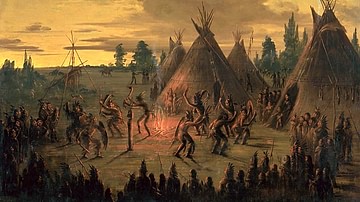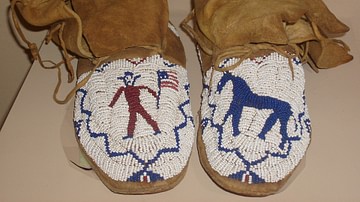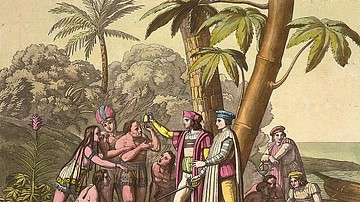The Penobscot are a Native American nation of the modern-day State of Maine, also recognized as a First Nation of Canada. Along with the Abenaki, Mi'kmaq, Passamaquoddy, and Wolastoqiyik, they form the Wabanaki Confederacy. Their origin tales, like those of all Native peoples of North America, feature animals, natural phenomena, and spirit beings including the supernatural entity Glooscap.
The Penobscot call themselves Penawahpkekeyak ("the people of the place of the white rocks"), a reference to their ancestral homeland along the Penobscot River. Early French explorers, misunderstanding the name or simply unable to pronounce it, referred to them as Penobscot, which the people then began to use to reference themselves.
According to Penobscot oral history and archaeological evidence, the people inhabited the land from at least 12,000 BCE. They first came into contact with Europeans in 1524, with the arrival of Giovanni da Verrazano (l. 1485-1528) and, between 1604-1607, encountered French and English traders, become involved in the fur trade, and at least five Penobscot helped establish the Popham Colony (1607-1608), the first English colony in the North American region that would become New England. The first Penobscot chief documented by Europeans was Bessabez (d. c. 1616), who assisted Samuel de Champlain (l. 1567-1635) in his exploration of the Penobscot River.
Between 1616 and 1619, at least 75% of the Penobscot nation died from European diseases, and more fell in the Beaver Wars (1638-1655) fought over territory in the fur trade. They sided with the French during the French and Indian War (1754-1763) and with the Continentals during the American Revolutionary War (1775-1783), after which, despite their contributions, the colonists took their land, consigning them to the reservation on Indian Island in the Penobscot River, where they still live, primarily, today.
Culture & Origin Tales
The Penobscot historically spoke the Algonquian language in the Eastern Abenaki dialect, and they were initially a hunter-gatherer society before establishing semi-permanent and then permanent settlements along the Penobscot River. Men hunted bears, beavers, caribou, deer, and moose, and harvested the river for fish and other marine creatures. They were also responsible for the protection of the village and wider Penobscot community and for making war on other nations.
The women built the homes, raised the children (the boys only up to a certain age, when they became their fathers' responsibilities), harvested herbs, roots, and vegetables, and tended to the crops. Even after permanent settlements were established, the Penobscot still roamed freely following game. All life was (and is) considered sacred by the Penobscot, and even those animals and water creatures killed for food were understood to be their relatives, as illustrated in the legend The Water Famine below.
Among the great legendary heroes of the Penobscot (as well as the others of the Wabanaki Confederacy and still others not affiliated) is Glooscap (also given as Glooskap, Kluscap, and other variations), a supernatural entity usually depicted as a force of good (as opposed to his brother Malsumsis, the Wolf) but sometimes as a trickster figure, who might be a hero, villain, fool, or wise man. The Glooscap tales, like the other Penobscot legends, serve to entertain while also relaying some important cultural value. The Water Famine, for example, is not only an origin tale but also emphasizes the value the Penobscot place on generosity, hospitality, and sharing.
The entire world is alive with spirits in Penobscot cosmology, and so the winds, the grasses, trees, rocks, and rivers have their own unique personalities, likes, and dislikes that must be respected, as do all the animals, plants, and other creatures. As with many other Native American nations, the Penobscot believe they came from the earth of their ancestral lands and are spiritually bound to it; and so one is never home unless one is home on one's own lands, a belief shared by all Native American nations.

After the Euro-American colonists forcibly relocated the Penobscot from their lands, they preserved their culture as best as they could and largely succeeded, though there are no more Penobscot fluent in Eastern Abenaki. A large part of their cultural heritage is their stories, however, which have been preserved and which, today, the Penobscot work to translate back into their native tongue or highlight those already known in Eastern Abenaki.
The tales below include Of Glooscap's Birth, The Water Famine, The Origin of Indian Summer, and The Giant and The Four Wind Brothers. The first three are origin tales explaining how the world or people or seasons came to be as they are, and the last illustrates the Penobscot's close relationship with the natural world, in this case in the form of the four winds.
Text
The following text is taken from Voices of the Winds: Native American Legends by Margot Edmonds & Ella Clark, except for Of Glooscap's Birth, which comes from The Algonquin Legends of New England, or Myths and Folklore of the Micmac, Passamaquoddy, and Penobscot Tribes by Charles Godfrey Leland.
Of Glooscap's Birth, and of his brother, Malsum the Wolf
Now the great lord Glooscap, who was worshiped in after-days by all the Wabanaki, or children of light, was a twin with a brother. As he was good, this brother, whose name was Malsumsis, or Wolf the Younger, was bad. Before they were born, the babes consulted to consider how they had best enter the world. And Glooscap said, "I will be born as others are." But the evil Malsumsis thought himself too great to be brought forth in such a manner and declared that he would burst through his mother's side. And as they planned it, so it came to pass. Glooscap as first came quietly to light, while Malsumsis kept his word, killing his mother.
The two grew up together, and one day the younger, who knew that both had charmed lives, asked the elder what would kill him, Glooscap. Now each had his own secret as to this, and Glooscap, remembering how wantonly Malsumsis had slain their mother, thought it would be misplaced confidence to trust his life to one so fond of death, while it might prove to be well to know the bane of the other. So, they agreed to exchange secrets, and Glooscap, to test his brother, told him that the only way in which he himself could be slain was by the stroke of an owl's feather, though this was not true. And Malsumsis said, "I can only die by a blow from a fern-root."
It came to pass in after-days that Kwah-beet-a-sis, the son of the Great Beaver, or, as others say, Miko the Squirrel, or else the evil, which was in himself, tempted Malsumsis to kill Glooscap; for in those days all men were wicked. So, taking his bow he shot Ko-ko-kkas the Owl, and with one of his feathers he struck Glooscap while sleeping. Then he awoke in anger, yet craftily said that it was not by an owl's feather, but by a blow from a pine-root, that his life would end.
Then the false man led his brother another day far into the forest to hunt, and, while he again slept, smote him on the head with a pine-root. But Glooscap arose unharmed, drove Malsumsis away into the woods, sat down by the brook-side, and thinking over all that had happened, said, "Nothing but a flowering rush can kill me." But the Beaver, who was hidden among the reeds, heard this, and hastening to Malsumsis told him the secret of his brother's life. For this Malsumsis promised to bestow on Beaver whatever he should ask; but when the latter wished for wings like a pigeon, the warrior laughed, and scornfully said, "Get thee hence; thou with a tail like a file, what need hast thou of wings?"
Then the Beaver was angry, and went forth to the camp of Glooscap, to whom he told what he had done. Therefore, Glooscap arose in sorrow and in anger, took a fern-root, sought Malsumsis in the deep, dark forest, and smote him so that he fell down dead. And Glooscap sang a song over him and lamented.

The Water Famine
From this legend we learn of the origin of fish, frogs, and turtles. A long, long time ago, Indians settled up the river. A Monster Frog forbade these Indians the use of water. Some died from thirst. Their Spirit Chief, Glooscap, came to help them. He saw how sickly his people seemed. He asked them, "What is your trouble?"
"The Monster is killing us with thirst. He forbids us water."
"I will make him give you water," Glooscap replied.
The people went with their chief to see the Monster Frog. The Chief said to the Monster Frog, "Why do you abuse our grandchildren? You will be sorry for this treatment of our good people. I will give them water, so all will have an equal share of the water. The benefits should be shared."
Glooscap suddenly grabbed the Monster Frog and broke his back. From thenceforth, all bullfrogs are broken-backed. Even then the Monster did not give up the water. So Glooscap took an axe and cut down a yellow birch tree so that, when it fell down, the yellow birch tree killed the Monster Frog.
That is how the Penobscot River originated. The water flowed from the Monster Frog. All the branches of the yellow birch tree became rivers, and all emptied into the main Penobscot River.
Now, all of the Penobscot Indians were so thirsty, some even near death, that they jumped into the river to enjoy the water inside and outside. Some of them turned into fish; some turned into frogs; some turned into turtles. A few human Penobscot survived. That is the reason they inhabit the whole length of the Penobscot River. This is how they took their family names from all kinds of fish, turtles, and other water creatures.
The Origin of Indian Summer
Long, long ago, the Penobscot Indians used to say, an old man went to the Chief of the Sky Spirits to ask his help. The man's name was Zuni. In the spring, when all his people were planting their vegetables, Zuni was too ill to do his usual planting. He was ill all summer. During that summer, his people, as usual, gathered their vegetables and dried them for use in the winter. But Zuni had none.
So, he went to the Chief of the Sky Spirits and said to him, "I have been sick all through the planting and the harvesting seasons. The winter is coming on, and I have no food ready for it. What am I to do?"
"I will help you," was the prompt reply. "Go ahead now. Plant your vegetables as you have always done in the spring. I will see that you have a crop right away."
Zuni went home and immediately put his seeds into the ground. The weather favored him, and almost as soon as he had finished planting, his crops were ready to harvest. In seven days, he had as much as any other man in his tribe had. Then winter came.
The Penobscot gave that warm period in the autumn a name that means Indian Summer. White people also call it Indian Summer.
The Giant and the Four Wind Brothers
There were four brothers in a family that lived in a huge cave on the top of a high mountain in the present state of Maine. One brother was Northwind, one Southwind, another Westwind, and the other one Eastwind. They were the ones who made all of the winds blow.
Westwind was the youngest, Northwind the oldest, Southwind second oldest, and Eastwind second youngest. To cause the winds, they stood up with their heads above the cave hole and blew. The forthcoming wind occurred according to whichever brother performed–North, South, East, or West.
Westwind was very wild when he blew. Northwind chided him "No, No! Don't do that! You will raise such high winds that you will destroy our good people, the Penobscot."
When Westwind jumped up again to blow, Northwind again told him, "No! No! Stop or you will kill our mother." So lived the Four Wind Brothers, causing and regulating the winds of the world.
Northwind was always the softest wind, Eastwind a little stronger and harsher, Southwind with strong gusts, but not as much as Westwind the youngest. Whenever the Four Wind Brothers blew the winds, they were not satisfied until each performed in his particular style to perfection.
Often, they would say to each other as a warning, "We must try to care for our friends, the Penobscot, so we do not destroy any thing or any one of them."
About this same time, a Giant Beaver had this home on the top of a great rock by the shore of Big Lake. This Giant Beaver, about one hundred feet long, had a very large lodge. Near him lived a Giant Penobscot who liked to hunt for the Giant Beaver. But Giant Penobscot lived in fear of a Monster Eagle, who kept watching all the time for the right moment to snatch and carry Giant Penobscot to its nest.
Monster Eagle was so large that he could pick up a giant man like an ordinary eagle would carry a rabbit, even though the giant was as tall as the tallest tree. At last Giant Penobscot's family was out of food, and he was compelled to go out and hunt. He took his long-handled ice chisel and went in search of the Giant Beaver.
Giant Penobscot succeeded in driving the Beaver from his Lodge, and he cornered him and killed him. After packing the Giant Beaver on his back, Giant Penobscot joyfully started homeward with his prize. Monster Eagle had seen Giant Penobscot from a great height. Down swooped the Eagle, picking up both Giant Beaver and Giant Penobscot, as easily as carrying two rabbits.
Far up on a rocky mountainside, Monster Eagle flew with its prey to its nest, which was thousands of feet above the valley. Monster Eagle's nest was enormous, with many young eagles in it. When Monster Eagle deposited his victims in the nest, he began feeding the dead beaver to his eaglets. Monster Eagle kept Giant Penobscot safely to one side, until all of the beaver had been eaten.
Then Monster Eagle prepared to kill the Giant Penobscot. He quickly flew high into the air and turned sharply, diving straight down to strike Giant Penobscot with his beak, wings, and claws. But Giant Penobscot held upright his sharp ice chisel with the butt end braced against a rocky ledge beside him. Monster Eagle descended violently upon the point of the ice chisel and he died instantly.
Now that Giant Penobscot was free, he wondered how he could get down to earth again before being eaten by the eaglets as they grew larger. He thought and thought, finally deciding to cut out the body of Monster Eagle and crawl inside the feathered skin, using Eagle's wings to glide down from the mountain.
Coincidentally, on this same mountain lived the Four Wind Brothers. Northwind saw Monster Eagle destroy himself. He also observed Giant Penobscot preparing to fly down to earth. Northwind called his three brothers to come and see.
"Let us all blow gently beneath Eagle's wings and help the good Penobscot to land softly upon the earth," said Northwind to his Brother Winds.
Inside Monster Eagle's wings, the Giant Penobscot soared off the mountain. Gently the Four Wind Brothers blew beneath his wings, guiding him while he easily floated to the Penobscot village below.
Meanwhile, when Giant Penobscot's family found that he had disappeared, they knew he must have been carried away by some flying giant, because his tracks led to nowhere.
One of the ancient men of the Penobscot tribe said, "We must all help our brother escape with our good thoughts. We must wish for his safe return by Chief of the Sky Spirits."
When Giant Penobscot floated safely back to his tribe and told his people of his adventure, the Ancient One said, "It was the strength of our wishes to Chief Sky Spirit that brought you back to your people. Now let us have a thanksgiving feast and rejoice."
Gently the Four Wind Brothers passed over the Penobscot Indian village on their happy return to their mountaintop cave.






